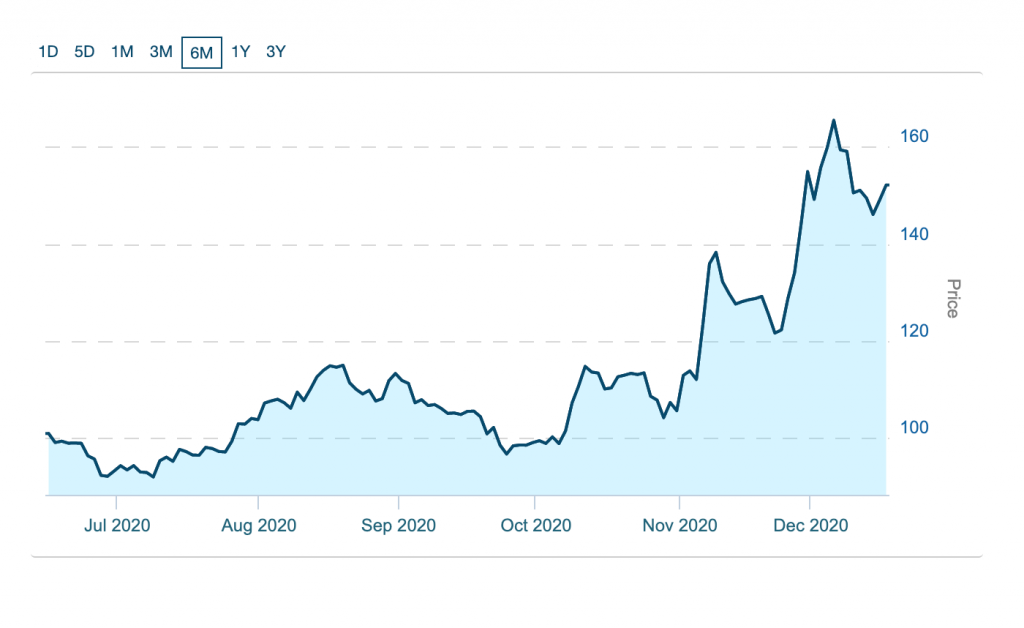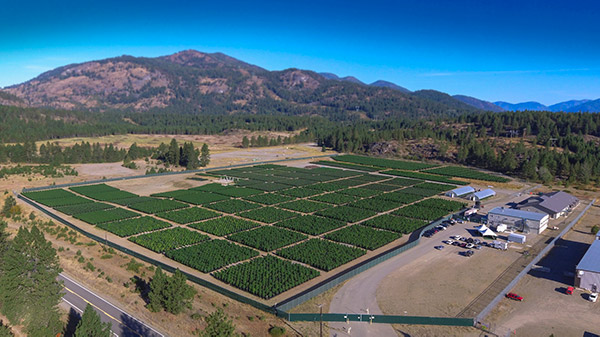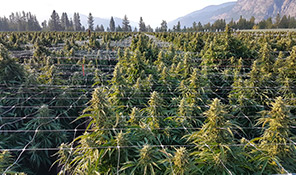It’s back. And one exciting group of stocks is beating the red hot S&P 500 by more than 2:1.
Here’s how to pick the next big winner! PLUS: Why Christina Lake Cannabis (CSE: CLC, OTC: CLCFFCSE: CLC, OTC: CLCFF) could top them all
If you thought the great cannabis stock boom was done and gone, here’s good news.
After the epic shakeout of 2019 and early 2020, cannabis stocks are roaring back.
In the past three months as of this writing (Dec 12), the North American Marijuana Index soared 234%.1
North American Marijuana Index March 18 to December 11, 2020

marijuanaindex.com
That’s nearly five times the gains of the S&P for the same period.
But look closely and you’ll see that one other group of stocks is creaming the S&P 500, as well.
Because, while the S&P’s nine-month 50% gain was nothing to sneeze at, another cannabis sector sub-group blew it out of the water, too, with a whopping 124% gain.2 And it’s still going strong.
To put that all into perspective, the S&P went on a five-alarm tear this year. Yet two indexes from an out-of-favor sector, with gains of 234% and 124%, made the S&P 500’s gains seem, well, humble, at best.
No other industry today is giving investors so much.
Not even semiconductors or gold are matching the returns of cannabis stocks.
And the best part is that this new cannabis bull market is just getting started.
Which means you haven’t missed your opportunity for outsized profits.
You’ve got a second chance to buy into one of the fastest growing markets in history
When you look at the numbers, the growth of the cannabis market is mind-boggling.
In the few short years since legalization, the market has already rocketed to more than $15 billion.3
But as impressive as that figure is, analysts at the esteemed 203-year old investment bank, Bank of Montreal (NYSE: BMO) are forecasting that the cannabis market will soar to an incredible $194 billion by 2025.4
Individual stocks in the sub-segment can suddenly explode too. Like the summertime burst that saw four sub-sector companies jump as high as 351%, 113%, 106%, and 104% in less than 90 days.5
Which is why professional investors are going all in. Their guidance started picking up in late June:
- On June 23, fund manager Luke Lango advised investors that “this big rally in pot stocks” is just the beginning of a bull run that is “only going to heat up in the second half of 2020.” 6
- On July 10, private equity firm CEO Andrew Laub said, “Now could be the best time to invest in cannabis.” 7
- On July 12, investment advisor Alan Brochstein said it’s time for investors “to be bullish on cannabis stocks.” 8
- On December 9, Motley Fool said “A ‘Green Wave’ is sweeping across North America. In November, voters in four states cast their ballots to legalize recreational marijuana, which will open up new cannabis markets in Arizona, Montana, New Jersey, and South Dakota. The North American legal marijuana market will likely reach $19.1 billion by next year and then grow at double-digit percentages annually.”
But before you run out and invest, don’t look for the same old names to lead this time around.
A new kind of cannabis company is taking the lead
A new generation of cannabis companies is rising up to dominate the market.
They are leaner, more efficient, and more focused on the bottom line than the mega-producers that led the 2017 cannabis bull market – and the 2018 crash.
They are avoiding the mistakes of the early-market companies by taking their time and making a detailed analysis of both the companies that made it and those that didn’t.
Early companies expanded too much too fast.
They overburdened themselves with ridiculously expensive grow operations.
Then they were blindsided by falling wholesale prices that decimated profit margins.
One of the companies that is successfully avoiding those mistakes is Christina Lake Cannabis, an ambitious new generation producer with some of the brightest prospects in the industry.

Christina Lake Cannabis (CSE: CLC, OTC: CLCFFCSE: CLC, OTC: CLCFF) : Fast-growing under-the-radar producer looks unstoppable
More than any other company, Christina Lake Cannabis has a strategy designed to ensure maximum profitability and dominant market position.

They are following the fundamental laws of business success: Top quality product with the highest profit margins made at the lowest possible cost:
- LOW PRODUCTION COSTS It is essential to cut every last ounce of fat off production costs, from plant to processing to product. While it used to be common for industry leaders to see all-in production costs of $396 per pound of dried flower, Christina Lake Cannabis is shaving that number down as low as $100 per pound or even less.9
- CONSISTANT HIGH QUALITY There is no real trick to producing low-cost cannabis. But producing high quality cannabis at a low cost requires skill and meticulous attention to detail that many producers haven’t been able to achieve. By focusing less on the raw plant material and more on the best extraction technology and methods, Christina Lake is able to produce cannabis oil that is as high quality and high potency as the most expensive products on the market.
- VALUE-ADDED PRODUCTS Cannabis is one of the most profitable crops in the world. But smart companies know that cannabis oils and edibles are even more profitable. That’s why the foundation of Christina Lake’s business is in producing low-cost, top-quality cannabis oils, which command average margins of 84%, and expansion into isolates and distillates, with margins that average a whopping 92%.10
Take a more detailed look at how this three-part model is guiding Christina Lake’s growth and attracting significant venture capital.
Why the investment focus is on Canada.
In Canada, recreational and medicinal cannabis are legal nationwide. In fact, Canada was the first G7 country to legalize recreational use. That’s proving to be a big advantage for Canadian producers.
This is very much in contrast to the U.S. where on the federal level marijuana is a Schedule I drug and deemed of no medical use just as heroin and LSD are.
The recent election there saw Arizona, Montana, New Jersey and South Dakota voters clear cannabis for adult recreation use, which brings to 15 the number of states where cannabis is legal for recreational use.
Whether for medical or recreational use, the issue is decided state by state. And that is why the U.S. market still operates as a patchwork of jurisdictions that function independently, each with different rules, taxes, and licensing.
And that’s why it’s exceedingly complex and costly for any company to be a multi-state operator (MSO), and next to impossible to achieve economies of scale that are essential to profitability.
The result is that MSOs are suffering steadily declining market cap and share price as they struggle to reach profitability.
As cannabis industry analyst Brandon A. Dorfman advised investors on August 3, “multi-state operators are losing value at an astonishing rate.”11
Dorfman went on to say that “the Canadian industry continues to reach new heights.”
MSOs are definitely not where you want to put your investment dollars today. They are part of the last generation of cannabis companies.
The new cannabis bull market is being led instead by companies like low-cost producer Christina Lake Cannabis.
Christina Lake Cannabis (CSE: CLC, OTC: CLCFFCSE: CLC, OTC: CLCFF) Guiding Principle #1: Keep a stranglehold on the bottom line.
Christina Lake holds a unique, some might say superior, advantage compared to the majority of its competitors.
It grows its cannabis outside, and that is infinitely more cost effective than indoor greenhouses. The latter, as you can imagine, have building upkeep, to go along with massive electric and watering costs.
The sun and rain are free which is how Christina Lake reportedly produces cannabis flower at just 6% of the latest reported cost from market leader Canopy Growth (CGC), and just 20% of the cost of the industry average.12
Canopy Growth and other big-name mega-cap producers like Tilray (TLRY) and Cronos Group (CRON) are struggling to reframe their business models after disastrous losses.
That’s how the last cannabis bull market ended.
High-flying companies that saw their valuations soar to billions of dollars failed to live up to investor expectations.
Those early companies were all focused on cannabis production – growing the plant and processing it into dried flower.
To ensure the highest quality product, they built high-tech indoor grow facilities equipped with everything from sensitive temperature control technology to automatic feeding systems.
The result was production costs as high as $6.83 per gram.13
As investors poured more and more money into cannabis companies, they used all that new-found cash to expand growing capacity as far and as fast as they could.
Then, as that capacity came online, and more and more producers entered the industry, overcapacity became a problem.
Prices plunged. Pot became a commodity, no different than wheat or corn. And those billion-dollar cannabis companies saw their margins shrink to next to nothing.
They were stuck with grossly expensive production facilities in a market that now competes primarily on price.
As these mega-producers struggle to re-frame their business models, investors are abandoning them in favor of smaller, smarter, more nimble competitors.
And that migration is reflected in their stock returns.
Canadian mega-producers have averaged returns of 17% since the March market bottom.
In contrast, smaller producers, most of which sport market caps below $50 million, have returned more than twice that at 40%.
Low-cost producers like Christina Lake Cannabis (CSE: CLC, OTC: CLCFFCSE: CLC, OTC: CLCFF) leading the way to achieve industry’s highest profit margins
Low-cost producers like Christina Lake are growing cannabis at a fraction of the cost of what indoor growers can achieve.
Instead of the business-killing $6.18 per gram cost from CannTrust or the Raymond James-estimated $4.00 per gram from Canopy Growth, Christina Lake Cannabis is producing at a cost of an estimated 11 cents per gram.14
Adding the $1.00 per gram cost of excise taxes, and estimating the wholesale price of cannabis at around $6.00 per gram, that gives Christina Lake an impressive profit margin, arguably among the highest in the entire industry.
And that’s just on simple dried flower. What Christina Lake is doing to convert dried flower into value-added product could send profit margins into the stratosphere.
Of course, low production costs wouldn’t mean much if they didn’t result in a quality product.
Christina Lake Cannabis (CSE: CLC, OTC: CLCFFCSE: CLC, OTC: CLCFF) Guiding Principle #2: Rely on science, not myth, to achieve the highest quality product
One of the secrets of Christina Lake’s astonishingly low production costs is that they’ve bucked the dominant trend and are growing their cannabis outdoors instead of in costly, hi-tech indoor facilities.
There’s a stubborn myth that cannabis grown indoors is more potent than cannabis grown outdoors.
It goes back to the old days when cannabis was illegal, and had to be grown one of two ways: either pampered indoors or sow-and-go outdoors.
Indoor-grown was hidden away in basements and garages where it thrived under constant care.
 Outdoor-grown was planted in clearings hacked from a wilderness area where all supplies, including water and fertilizer, had to be carried in on foot, often for long distances.
Outdoor-grown was planted in clearings hacked from a wilderness area where all supplies, including water and fertilizer, had to be carried in on foot, often for long distances.
So it’s no wonder that people came to the conclusion that the pampered indoor cannabis was naturally more potent than sow-and-go outdoor plant.
That enduring myth is why cannabis companies sunk tens of millions of dollars into expensive indoor grow facilities.
But Christina Lake Cannabis relies on science, not superstition. And on expertise, not trial and error.
Christina Lake’s plant geneticists spent more than a decade working to develop and perfect a portfolio of cannabis strains that would blow away the competition.
They would do this by creating a plant that has the yield and potency of the best indoor-grown cannabis, but produced at the far lower cost of outdoor-grown.
In short, they would put the old myths to rest.
A decade-long search to find the secret to 5 times higher potency
While the company’s breeders worked rigorously to identify and propagate plant strains with the best genetic qualities, there was a separate breakthrough that gave solid proof to Christina Lake’s ultimate goal.
A landmark study published in the peer-reviewed plant pharmacology journal Planta Medica had finally put the indoor-outdoor myth to the test.
The academic researchers grew two sets of cannabis plants, one indoors and one outdoors.
After reaching maturity, both sets were harvested and analyzed in a laboratory.
Contrary to popular myth, the scientists were surprised to find that the field-grown cannabis had higher concentrations of both THC and CBD.15
While the indoor plants averaged 2.54 mg of THC per gram, the outdoor-grown plants averaged 12.24 mg – nearly five times higher.
Likewise, field-grown plants averaged 7.79 micrograms per gram of CBD, compared to just 2.6 for indoor-grown – three times higher.
And that’s before any processing.
That study gave the Christina Lake team even more determination to develop the highest potency, lowest cost cannabis cultivar possible.
By using only the most advanced plant breeding techniques to identify and select for the most desirable plant traits, the company created a portfolio of high yield, high potency cannabis strains that are optimized for commercial outdoor growing.
Each proprietary strain was created under strict compliance with Canada’s Access to Cannabis for Medical Purposes Regulation (ACMPR), as well as the MMAR and MMPR regulations that preceded it.
The result of that decade-long development period was something that would give them a clear and powerful edge over their competitors.
Today Christina Lake actively farms 18 of their 32 fully licensed acres of land in an area which some have called the “Napa Valley of Canada.”
Located in the southern interior of British Columbia, the region is one of Canada’s most productive agricultural regions.
Fertile soil, abundant sunshine, and a temperate microclimate make the area perfect for growing specialty crops, including cannabis.
The company also has an adjacent 99-acre expansion property, which it can bring into production at any time.
Christina Lake Cannabis (CSE: CLC, OTC: CLCFFCSE: CLC, OTC: CLCFF) Guiding Principle #3: Boost profit margins higher with value-added products
A few years ago, the vast majority of the cannabis market consisted of dried flower that users smoked either in pipes or rolled into cigarettes.
But the popularity of smoking is falling lower every day. Not only do people realize that smoking is unhealthy, there is a lot of cultural anti-smoking pressure.
Today flower is only about 40% of the market – and shrinking.
Consumers are turning instead to oils and edibles, which both have higher profit margins than dried flower.
In September 2020, Christina Lake Cannabis harvested its first big crop, yielding more than 33,000 lbs. of high-grade dried cannabis flower from an initial 18 acre grow. And now, after the successful inaugural harvest that doubled production targets, Christina Lake is planning to expand growing operations to include another 85 acres of arable land for the 2021 growing season.
The company’s state-of-the-art, fully licensed, 12,000 square foot extraction facility boasts advanced supercritical CO2 technology to achieve cannabis extract with the highest degree of stability, antioxidant capacity, yield, and cannabinoid composition.
The result is an end product that is equal to or better than anything produced from even the highest grade indoor-grown cannabis.
The extract can either be sold in the wholesale market, branded and marketed at the retail level, or incorporated into even higher-margin products like edibles.

As a simple speculation, even selling the extract the fastest and easiest way possible, into the wholesale market, Christina Lake could be looking at potential revenue in the tens of millions.
And that is not taking into account the product’s superior quality, but instead using only the average industry standards to estimate yield, costs, and wholesale prices.16
As we get closer to when the product becomes available for sale, and as sales start accumulating, the news will get out.
That’s the kind of news that savvy investors watch for. They want to get in before the herd to take advantage of the rising share price. And there’s nothing like growing revenue to quickly lift the stock price.
The time is right to take a closer look at Christina Lake Cannabis (CSE: CLC, OTC: CLCFFCSE: CLC, OTC: CLCFF)
It’s still early in the new cannabis bull market. The research firm ArcView estimates a compound annual growth rate of 47% over the next 10 years.19
But don’t count on companies that dominated cannabis’s first wave of growth to continue their domination.
Instead, look to innovative new companies to dominate the second wave of growth. Companies with top quality products with high profit margins, made at the lowest production cost.
With their smart strategy and high potential, Christina Lake Cannabis is ready to take off.
Ask your broker about Christina Lake Cannabis (CSE: CLC, OTC: CLCFFCSE: CLC, OTC: CLCFF) today. And don’t forget to always perform your own due diligence research before investing in any stock.
1 https://marijuanaindex.com/stock-quotes/north-american-marijuana-index-tracking-top-cannabis-stocks-in-north-america/
2 https://marijuanaindex.com/stock-quotes/canadian-marijuana-index-tracking-top-cannabis-stocks-in-canada/
3 https://www.businesswire.com/news/home/20200116005248/en/Global-Cannabis-Sales-Grow-48-15-Billion
4 https://www.investopedia.com/why-big-investors-eying-usd194-billion-market-are-high-on-cannabis-4692135
5 CPMD, CNPOF, VFF, WDDMF
6 https://www.businesswire.com/news/home/20200116005248/en/Global-Cannabis-Sales-Grow-48-15-Billion
7 https://www.chicagotribune.com/marijuana/sns-tft-cannabis-investing-coronavirus-pandemic-20200710-zgwgwzgb5nhlhbngv7hzyuk43i-story.html
8 https://www.forbes.com/sites/alanjbrochstein/2020/07/12/three-reasons-to-be-bullish-on-cannabis-stocks/#41c3697e5bfc
9 https://www.cannabisbusinesstimes.com/article/cannabis-production-costs-research-data/
10 https://grizzle.com/economics-marijuana-edibles/
11 https://www.potnetwork.com/news/these-three-us-cannabis-stocks-are-poised-rebound-2020
12 https://www.cantechletter.com/2019/10/organigram-will-be-a-winner-in-the-cannabis-price-war-says-raymond-james/
13 https://smallcappower.com/top-stories/canadian-cannabis-producers/
14 https://smallcappower.com/top-stories/canadian-cannabis-producers/
15 https://pubmed.ncbi.nlm.nih.gov/25338935/
16 Bud yield per acre = 575 lbs https://www.rand.org/content/dam/rand/pubs/working_papers/2010/RAND_WR764.pdf; 220 grams bud = 1 oz oil https://www.quora.com/How-much-cannabis-does-it-take-to-make-an-ounce-of-cannabis-oil; wholesale oil price $163.32/oz https://bulksupplycbd.com/
17 https://globenewswire.com/news-release/2018/02/26/1387588/0/en/NEW-REPORT-Worldwide-spending-on-legal-cannabis-will-reach-57-billion-by-2027.html
IMPORTANT NOTICE AND DISCLAIMER
This website is owned and hosted by Market Tactic Media Ltd. Articles appearing on this website should be considered paid advertisements. Market Tactic Media Ltd. and its owners, managers, employees, and assigns (collectively “the Publisher”) is often paid by marketing companies to host websites on which articles profiling public companies are published. The Publisher has not been compensated by any of the profiled companies. The Publisher’s compensation for articles appearing on this website is as follows:
- The Publisher has been paid approximately $500 per week while the advertisement campaign was active by Think Ink Media as compensation to host the article profiling Christina Lake Cannabis.
The Publisher has not participated in the creation of the content of any articles appearing on this website and so cannot guarantee the accuracy or completeness of the information in any of the articles. The Publisher expressly disclaims any responsibility or liability for statements made in any of the articles.
SHARE OWNERSHIP. The Publisher does not own any shares of any profiled company and has no information concerning share ownership by others of any profiled company. The Publisher cautions readers to beware that third parties, profiled companies, and/or their affiliates may liquidate shares of the profiled companies at any time, including at or near the time you read the articles on this website and this has the potential to hurt share prices. Frequently companies profiled in such articles experience a large increase in volume and share price during the course of investor awareness marketing, which often ends as soon as the investor awareness marketing ceases.
NO SECURITIES OFFERED. The articles on this website are not, and should not be construed to be, offers to sell or solicitations of an offer to buy any security. Neither the articles on this website nor the Publisher purport to provide a complete analysis of any company or its financial position. The Publisher is not, and does not purport to be, a broker-dealer or registered investment adviser. The articles on this website are not, and should not be construed to be, personalized investment advice directed to or appropriate for any particular investor. Any investment should be made only after consulting a professional investment advisor and only after reviewing the financial statements and other pertinent corporate information about the company. Further, readers are advised to read and carefully consider the Risk Factors identified and discussed in the profiled company’s SEC and/or other government filings. Investing in securities, particularly microcap securities, is speculative and carries a high degree of risk.
INDEMNIFICATION/RELEASE OF LIABILITY. By reading articles on this website, you acknowledge that you have read and understood this disclaimer, and further that to the greatest extent permitted under law, you release the Publisher, its affiliates, assigns and successors from any and all liability, damages, and injury from articles appearing on this website. You further warrant that you are solely responsible for any financial outcome that may come from your investment decisions.
LINKS TO THIRD PARTY WEBSITES. This website enables users to link to external websites not under the control of The Publisher. The Publisher has no control over the nature, content, and availability of those sites. The inclusion of any links is not intended as, and should not be construed as, a recommendation or endorsement of the content or views expressed on such external websites. The Publisher expressly disclaims any representation concerning the quality, safety, suitability, or reliability of any external websites and the content and materials contained in them. It is important for users to take necessary precautions, especially to ensure appropriate safety.
INTELLECTUAL PROPERTY. The Market Tactic is the Publisher’s trademark. All other trademarks used in this communication are the property of their respective trademark holders. The Publisher is not affiliated, connected, or associated with, and is not sponsored, approved, or originated by, the trademark holders unless otherwise stated. No claim is made by the Publisher to any rights in any third-party trademarks.







